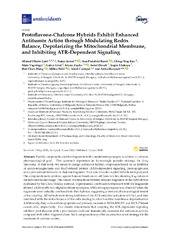Приказ основних података о документу
Protoflavone-Chalcone Hybrids Exhibit Enhanced Antitumor Action through Modulating Redox Balance, Depolarizing the Mitochondrial Membrane, and Inhibiting ATR-Dependent Signaling
| dc.creator | Latif, Ahmed Dhahir | |
| dc.creator | Jernei, Tamás | |
| dc.creator | Podolski-Renić, Ana | |
| dc.creator | Kuo, Ching-Ying | |
| dc.creator | Vágvölgyi, Máté | |
| dc.creator | Girst, Gábor | |
| dc.creator | Zupkó, István | |
| dc.creator | Develi, Sedef | |
| dc.creator | Ulukaya, Engin | |
| dc.creator | Wang, Hui-Chun | |
| dc.creator | Pešić, Milica | |
| dc.creator | Csámpai, Antal | |
| dc.creator | Hunyadi, Attila | |
| dc.date.accessioned | 2020-07-02T10:46:55Z | |
| dc.date.available | 2020-07-02T10:46:55Z | |
| dc.date.issued | 2020 | |
| dc.identifier.issn | 2076-3921 | |
| dc.identifier.uri | https://www.mdpi.com/2076-3921/9/6/519 | |
| dc.identifier.uri | https://radar.ibiss.bg.ac.rs/handle/123456789/3720 | |
| dc.description.abstract | Hybrid compounds combine fragments with complementary targets to achieve a common pharmacological goal. This approach represents an increasingly popular strategy for drug discovery. In this work, we aimed to design antitumor hybrid compounds based on an inhibitor of ataxia-telangiectasia and Rad3-related protein (ATR)-dependent signaling, protoapigenone, and a pro-oxidant ferrocene or chalcone fragment. Four new triazole-coupled hybrids were prepared. The compounds were cytotoxic against human breast cancer cell lines in vitro, showing IC50 values in the sub-micromolar range. The nature of interactions between relevant fragments of the hybrids was evaluated by the Chou–Talalay method. Experimental combination treatment with the fragments showed additive effects or slight/moderate synergism, while strong synergism was observed when the fragments were virtually combined into their hybrids, suggesting a relevant pharmacological benefit of the coupling. All hybrids were strong inhibitors of the ATR-mediated activation of Chk1, and they interfered with the redox balance of the cells leading to mitochondrial membrane depolarization. Additionally, they induced late apoptosis and primary necrosis in MDA-MB-231 and MCF-7 breast cancer cells, respectively. Our results demonstrate that coupling the ATR-dependent signaling inhibitor protoflavone with a pro-oxidant chalcone dramatically increases the antitumor activity compared with either fragment alone. Such compounds may offer an attractive novel strategy for the treatment of various cancers. | en |
| dc.publisher | MDPI AG | |
| dc.relation | National Research, Development and Innovation Office, Hungary (NKFIH; K-119770 and K-129037) | |
| dc.relation | Ministry of Human Capacities, Hungary grant 20391-3/2018/FEKUSTRAT | |
| dc.rights | openAccess | |
| dc.rights.uri | https://creativecommons.org/licenses/by/4.0/ | |
| dc.source | Antioxidants | |
| dc.subject | Antitumor natural product | |
| dc.subject | Chalcone | |
| dc.subject | DNA damage response | |
| dc.subject | Ferrocene | |
| dc.subject | Fragment-based drug design | |
| dc.subject | Hybrid compound | |
| dc.subject | Oxidative stress | |
| dc.subject | Protoflavone | |
| dc.subject | Virtual combination study | |
| dc.title | Protoflavone-Chalcone Hybrids Exhibit Enhanced Antitumor Action through Modulating Redox Balance, Depolarizing the Mitochondrial Membrane, and Inhibiting ATR-Dependent Signaling | en |
| dc.type | article | en |
| dc.rights.license | BY | |
| dcterms.abstract | Гирст, Гáбор; Зупкó, Иствáн; Девели, Седеф; Улукаyа, Енгин; Подолски-Ренић, Aна; Јернеи, Тамáс; Куо, Цхинг-Yинг; Wанг, Хуи-Цхун; Пешић, Милица; Цсáмпаи, Aнтал; Хунyади, Aттила; Латиф, Aхмед Дхахир; Вáгвöлгyи, Мáтé; | |
| dc.rights.holder | © 2020 by the authors. Licensee MDPI, Basel, Switzerland. | |
| dc.citation.issue | 6 | |
| dc.citation.volume | 9 | |
| dc.identifier.doi | 10.3390/antiox9060519 | |
| dc.identifier.pmid | 32545536 | |
| dc.identifier.scopus | 2-s2.0-85086673123 | |
| dc.identifier.wos | 000551232600001 | |
| dc.citation.apa | Latif, A. D., Jernei, T., Podolski-Renić, A., Kuo, C.-Y., Vágvölgyi, M., Girst, G., et al. (2020). Protoflavone-Chalcone Hybrids Exhibit Enhanced Antitumor Action through Modulating Redox Balance, Depolarizing the Mitochondrial Membrane, and Inhibiting ATR-Dependent Signaling. Antioxidants, 9(6), 519. | |
| dc.citation.vancouver | Latif AD, Jernei T, Podolski-Renić A, Kuo C-Y, Vágvölgyi M, Girst G, Zupkó I, Develi S, Ulukaya E, Wang H-C, Pešić M, Csámpai A, Hunyadi A. Protoflavone-Chalcone Hybrids Exhibit Enhanced Antitumor Action through Modulating Redox Balance, Depolarizing the Mitochondrial Membrane, and Inhibiting ATR-Dependent Signaling. Antioxidants. 2020;9(6):519. | |
| dc.citation.spage | 519 | |
| dc.type.version | publishedVersion | |
| dc.identifier.fulltext | https://radar.ibiss.bg.ac.rs/bitstream/id/6307/Antioxidants_2020_9_6_519.pdf | |
| dc.citation.rank | aM21 |

